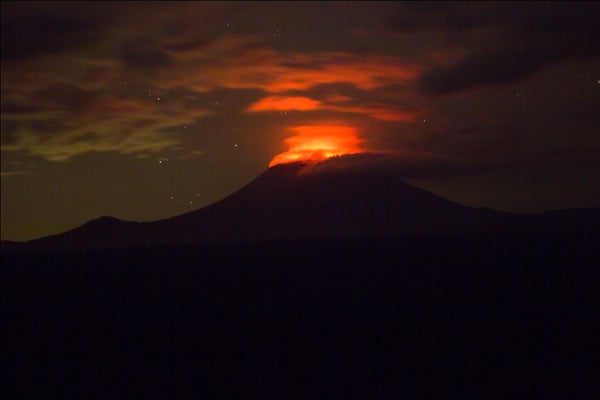This article was published in Scientific American’s former blog network and reflects the views of the author, not necessarily those of Scientific American
Black History Month ends today. This is the perfect time to introduce you to four black geoscientists who made history and are helping build our future. I encourage you to check out the National Association of Black Geoscientists and the Black Geoscientists website for many more awesome earth scientists.
John T. Leftwich
Dr. Leftwich fell in love with geology when he took an elective Earth Science course in college. Dr. Mack Gipson, one of America's first black geoscientists, encouraged him to pursue a degree in the new geology department he'd created at Virginia State University. Dr. Leftwich became the department's first graduate in 1969 - and was only the 7th African American in the country to graduate with a geoscience degree.
On supporting science journalism
If you're enjoying this article, consider supporting our award-winning journalism by subscribing. By purchasing a subscription you are helping to ensure the future of impactful stories about the discoveries and ideas shaping our world today.
He went on to get his master's at the University of Massachusetts and his PhD at Penn State, and spent a long and productive career researching oddities in sedimentary basins. He was an expert in petroleum geology, working for major oil companies and holding a position as professor at Old Dominion University. He became a founding member of the National Association of Black Geoscientists, and held the organization together through the lean years of 1986-89, when a downturn in the oil industry led to an exodus of geologists. Because of his dedicated work, the organization survived and is thriving today.
He volunteered for over twenty years at schools ranging from elementary to community college, ensuring new generations of students would have the opportunity to fall in love with the good science of rock-breaking. For his efforts, he was awarded the GSA Bromery Award in 2009.
Read more about Dr. Leftwich here.
Zelma Maine Jackson
Black geologists were rare in the 1970s. Black women in the geosciences were far rarer. Zelma Maine Jackson, a member of the Gullah-Geechee Nation, didn't take any easy routes. She became an exploration geologist with the Atlantic Richfield Oil company, searching for uranium in the Rockies using drill cores.
After finding many deposits that were successfully mined, she moved on to the University of Washington, where she got her Masters in Economic Geology and turned her career focus to cleaning up nuclear waste. She landed at the Hanford Nuclear Site in the 80s, and has been working for the Washington Department of Ecology Nuclear Waste Program for over twenty years, helping to decontaminate critical groundwater sources in eastern Washington.
She is dedicated to more than just cleaning up the environment. She's worked in a variety of government efforts to advocate for citizens of communities impacted by hazardous waste. She was a founding member of the NABG, has been a board member of the American Red Cross, United Way, Rotary International, and various public schools. And she dedicates time to saving sea turtles in her native South Carolina. She is a geoscience superwoman.
Read more about Zelma Maine Jackson here and read her jaw-dropping story of defying death with two drill rig guys here.
Bernard Hubbard
Dr. Hubbard is proof positive you can grow up in Brooklyn and still have a passion for rocks. He fell in love with the planetary and earth sciences as a child, but studied biological sciences in high school. A last-minute decision to enter a rock and fossil contest entry at a city-wide science competition won him third prize and set him on the path to the geosciences.
With his mom, grandma, and aunt all supporting his scientific interests, he put himself through college at Cornell University, earning a degree in earth sciences, before going on to obtain his graduate degree at the University at Buffalo.
While at university, he analyzed the risk of active volcanoes to the people living near them using computer modeling. He now works for the United States Geological Survey as a research geologist. He uses aircraft and satellite-mounted instruments to search for rare earth elements, as well as using them to assess hazards from landslides, volcanic edifice failures, and debris flows.
You can read about Dr. Hubbard's college experiences here, and more about his USGS work here.
Estella Atekwana
Dr. Atekwana wasn't about to be told she couldn't do science. She grew up in Cameroon, where her parents urged her to focus her studies on classes that would help her get a career in medicine. But in a high school geology class, her teacher told her geology wasn't for girls. She decided to show him the error of his ways. That year, she won awards for chemistry, biology, and geology.
She came to North America to pursue her higher education, earning her BS and MS in geology and her PhD in geophysics. She's now the Sun Company Clyde Wheeler Chair Professor of Hydrogeology at Oklahoma State University.
Dr. Atekwana is using all of her formidable talents in multiple branches of science to pursue the geophysical signs of the earliest life on Earth. She's also researching the initiation of continental rifts, focusing on the East African Rift Zone, where we can watch a rift zone being born. Her career spans the deep past and distant future of our planet, and her work in higher education ensures the future of American geoscience.
You can read more about Dr. Atekwana's present work here, and read about how she got there here.
